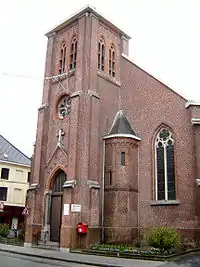Risquons-Tout
Risquons-Tout is a hamlet in the municipality of Mouscron in Hainaut province, Belgium on the frontier with France. It is primarily known for the Risquons-Tout incident, in which a group of Belgian émigrés entered the country carrying arms in an attempt to overthrow the Belgian government during the Revolutions of 1848.
Risquons-Tout | |
|---|---|
Village | |
 The Church of Saint Paul in Risquons-Tout. | |
 Risquons-Tout Risquons-Tout in Belgium | |
| Coordinates: 50°45′10″N 3°11′16″E | |
| Country | Belgium |
| Region | Wallonia |
| Province | Hainaut |
| Municipality | Mouscron |
Name
In French, Risquons-Tout literally means "Let's risk it all" or "Let's risk everything". The name derives from a sign for a bar (cabaret) that once occupied the site but which is no longer in existence.[1]
Location
The hamlet lies on a national border, immediately adjacent to Neuville-en-Ferrain and Tourcoing in France, and on a regional border, adjacent to Rekkem in Flanders. Risquons-Tout was once part of the municipality of Rekkem. In 1963, when the Belgian-language border was fixed, it was transferred to the city of Mouscron.
Risquons-Tout incident

Shortly after the French Revolution of 1848, Belgian migrant workers living in Paris were encouraged to return to Belgium to overthrow the monarchy and establish a republic.[2] Around 6,000 émigrés, coming from Paris, formed the Belgian Legion. The legion, equipped with weaponry by some of the administrative authorities of Lille, intended to penetrate into Belgium to "raise the people" and overthrow the Belgian monarchy. It is likely that the revolutionaries had the support of Alphonse de Lamartine, Minister of Foreign Affairs of the French Second Republic, which had only recently been installed and was still very militant.[3] The first group of revolutionaries attempted to travel into Belgium by train; they were stopped and quickly disarmed at Quiévrain on March 26, 1848.[4]
The 2000-man-strong second group entered Belgium at dawn on March 29 at Risquons-Tout. The revolutionaries were met by around 250 infantrymen of the Belgian Army under the command of General Joseph Fleury-Duray. A heavy cannonade routed the revolutionaries in only two hours, killing seven and wounding 26. Sixty revolutionaries were captured. Some of the captured were imprisoned in the Citadel of Huy, and 17 of them were condemned to death and executed at Antwerp.[5]
Several smaller revolutionary groups managed to infiltrate Belgium, but the reinforced Belgian border troops were successful in keeping order, and the defeat at Risquons-Tout effectively ended the revolutionary threat to Belgium. Later two streets were named after the incident, and a monument was erected in the local cemetery.
References
- Jespers, Jean-Jacques (2005). Dictionnaire des noms de lieux en Wallonie et à Bruxelles [Dictionary of Place Names in Wallonia and Brussels] (in French). Lannoo. p. 510.
- Chastain, James. "Belgium in 1848". Encyclopedia of 1848 Revolutions. Ohio University. Retrieved 16 December 2013.
- Gooch, Brison D., Belgium and the February Revolution, 2012:81.
- Ascherson, Neal (1999). The King Incorporated: Leopold the Second and the Congo (New ed.). London: Granta. pp. 20–1. ISBN 1862072906.
- Garnier-Pagès, Louis-Antoine (1866). Histoire de la Révolution de 1848. II (2nd ed.). Paris: Pagnerre. pp. 263–273.